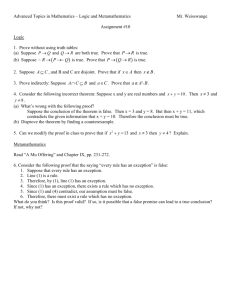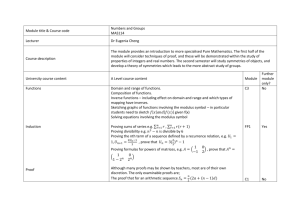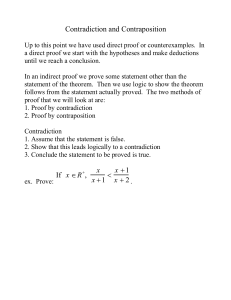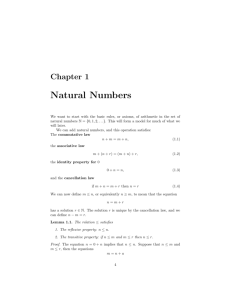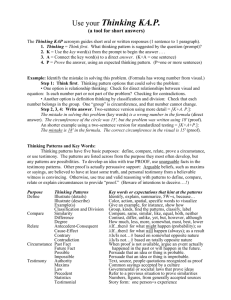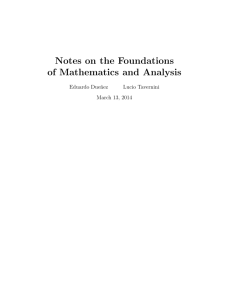Lecture 4: Natural numbers and cardinality Last time we discussed
advertisement
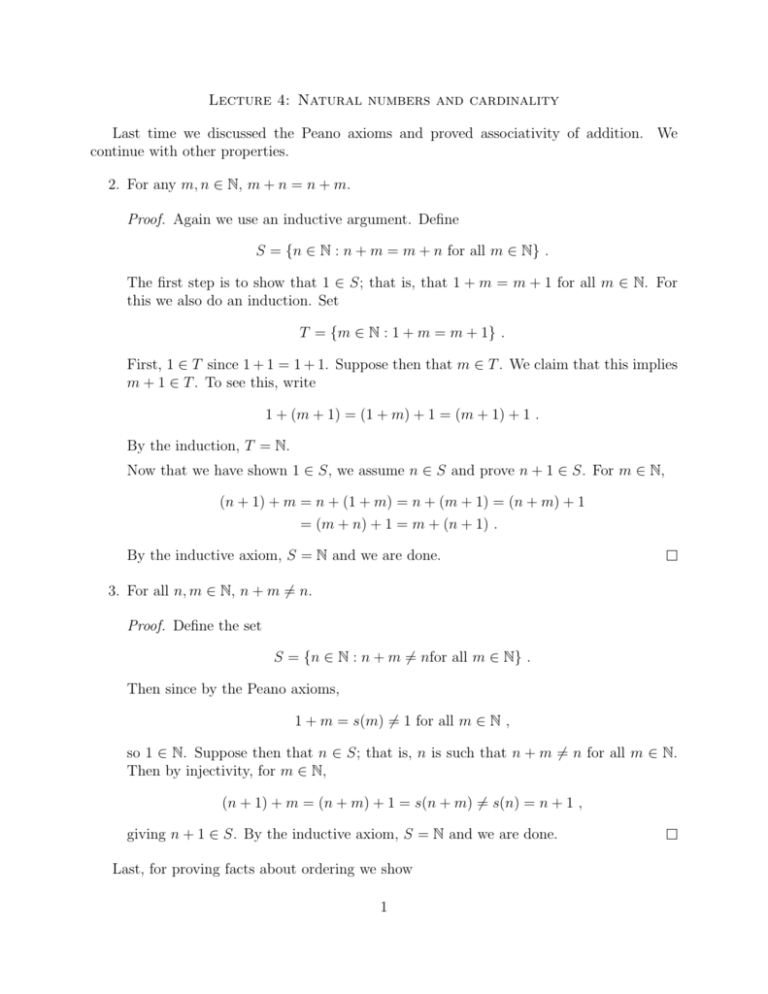
Lecture 4: Natural numbers and cardinality
Last time we discussed the Peano axioms and proved associativity of addition. We
continue with other properties.
2. For any m, n ∈ N, m + n = n + m.
Proof. Again we use an inductive argument. Define
S = {n ∈ N : n + m = m + n for all m ∈ N} .
The first step is to show that 1 ∈ S; that is, that 1 + m = m + 1 for all m ∈ N. For
this we also do an induction. Set
T = {m ∈ N : 1 + m = m + 1} .
First, 1 ∈ T since 1 + 1 = 1 + 1. Suppose then that m ∈ T . We claim that this implies
m + 1 ∈ T . To see this, write
1 + (m + 1) = (1 + m) + 1 = (m + 1) + 1 .
By the induction, T = N.
Now that we have shown 1 ∈ S, we assume n ∈ S and prove n + 1 ∈ S. For m ∈ N,
(n + 1) + m = n + (1 + m) = n + (m + 1) = (n + m) + 1
= (m + n) + 1 = m + (n + 1) .
By the inductive axiom, S = N and we are done.
3. For all n, m ∈ N, n + m 6= n.
Proof. Define the set
S = {n ∈ N : n + m 6= nfor all m ∈ N} .
Then since by the Peano axioms,
1 + m = s(m) 6= 1 for all m ∈ N ,
so 1 ∈ N. Suppose then that n ∈ S; that is, n is such that n + m 6= n for all m ∈ N.
Then by injectivity, for m ∈ N,
(n + 1) + m = (n + m) + 1 = s(n + m) 6= s(n) = n + 1 ,
giving n + 1 ∈ S. By the inductive axiom, S = N and we are done.
Last, for proving facts about ordering we show
1
• s is a bijection from N to N \ {1}.
Proof. We know s does not map any element to 1 so s is in fact a function to N \ {1}.
Also it is injective. To show surjective, consider the set
S = {1} ∪ {s(n) : n ∈ N} .
Clearly 1 ∈ S. Supposing that n ∈ S then n ∈ N, so s(n) ∈ S. Therefore S = N.
Therefore if k 6= 1 then k = s(n) for some n ∈ N.
The above lets us define n − 1 for n 6= 1. It is the element such that (n − 1) + 1 = n.
Ordering
We also define an ordering on the natural numbers. We say that m ≤ n for m, n ∈ N if
either m = n or m + a = n for some a ∈ N. This defines a total ordering of N; that is, it is
a partial ordering that also satisfies
• for all m, n ∈ N, m ≤ n or n ≤ m.
In the case that m ≤ n but m 6= n we write m < n. Note that by item 3 above, n < n + m
for all n, m ∈ N. In particular, n < s(n).
Proposition 0.1. ≤ is a total ordering of N.
Proof. First each n ≤ n so it is reflexive. Next if n1 ≤ n2 and n2 ≤ n3 then if n1 = n2 or
n2 = n3 , we clearly have n1 ≤ n3 . Otherwise there exists m1 , m2 ∈ N such that n1 + m1 = n2
and n2 + m2 = n3 . In this case,
n3 = n2 + m2 = (n1 + m1 ) + m2 = n1 + (m1 + m2 ) ,
giving n1 ≤ n3 .
For antisymmetry, suppose that m ≤ n and n ≤ m. For a contradiction, if m 6= n then
there exists a, b ∈ N such that m = n+a and n = m+b. Then m = (m+a)+b = m+(a+b),
a contradiction with item 3 above. Therefore m = n.
So far we have proved that ≤ is a partial order. We now prove ≤ is a total ordering. To
begin with, we claim that for all n ∈ N, 1 ≤ n. Clearly this is true for n = 1. If we assume
it holds for some n then
n+1=1+n≥1 ,
verifying the claim by induction.
Now for any m > 1 (that is, m ∈ N with m 6= 1), define the set
S = {n ∈ N : n ≤ m} ∪ {n ∈ N : m ≤ n} .
By the above remarks, 1 ∈ S. Supposing now that n ∈ S for some n ∈ N, we claim that
n + 1 ∈ S. To show this, we have three cases.
2
1. Case 1: n = m. In this case, n + 1 = m + 1 ≥ m, giving n + 1 ∈ S.
2. Case 2: n > m, so there exists a ∈ N such that n = m+a. Then n+1 = m+a+1 ≥ m,
giving n + 1 ∈ S.
3. Case 3: n < m, so there exists a ∈ N such that m = n+a. If a = 1 then n+1 = m ∈ S.
Otherwise a > 1, implying that a − 1 ∈ N (that is, a − 1 is defined), so
m = n + a = n + a − 1 + 1 = (n + 1) + a − 1 > n + 1 ,
so that n + 1 ∈ S. By the inductive axiom, S = N and therefore for all n, we have
n ≤ m or m ≤ n.
A consequence of these properties is trichotomy of the natural numbers. For any m, n ∈
N, exactly one of the following holds: m < n, m = n or n < m.
A property that relates addition and ordering is
• if m, n, r ∈ N such that m < n then m + r < n + r.
Proof. There must be a ∈ N such that n = m + a. Then n + r = m + a + r = m + r + a,
giving m + r < n + r.
Clearly then if m ≤ n and r ∈ N we have m + r ≤ n + r.
• If n < k then n + 1 ≤ k.
Proof. If n < k then there exists j ∈ N such that n + j = k. Because 1 ≤ j we find
n + 1 ≤ n + j = k.
Multiplication.
We define multiplication inductively by
n · 1 = n for all n ∈ N
n · s(m) = n + (n · m) .
One can prove the following properties; (try it!) let m, n, r, s ∈ N:
1. for all n, m, r ∈ N,
n · (m + r) = (n · m) + (n · r) .
2. n · m = m · n.
3. (n · m) · r = n · (m · r).
4. if n < m and r ≤ s then rn < sm.
3
Back to cardinality.
For each n ∈ N we write the set
Jn = {m ∈ N : m ≤ n} .
Note that J1 = {1} and for n ≥ 1, we have
Jn+1 = Jn ∪ {n + 1} .
To show this let k be in the right side. If k = n + 1 then k ∈ Jn+1 . Otherwise k ≤ n, giving
by n ≤ n + 1 the inequality k ≤ n + 1, or k ∈ Jn+1 . To prove the inclusion ⊂, suppose that
k ∈ Jn+1 . If k ∈ Jn we are done, so suppose that k ∈
/ Jn . Therefore k > n, so k ≥ n + 1. On
the other hand, k ≤ n + 1, so k = n + 1.
Definition 0.2. For an arbitrary set A we say that A has cardinality n if A ' Jn . In this
case we say A is finite and we write ](A) = n. If A is not equivalent to any Jn we say A is
infinite.
In this definition, ](A) is an equivalence class of sets and n is a number, so what we have
written here is purely symbolic: it means A ' Jn .
Lemma 0.3. If A and B are sets such that A ⊂ B then ](A) ≤ ](B).
Proof. Define f : A → B by f (a) = a. Then f is an injection.
Theorem 0.4. For all n ∈ N, ](Jn ) < ](Jn+1 ) < ]N.
Proof. Each set above is a subset of the next, so the proposition holds using ≤ instead of
<. We must then prove 6= in each spot above. Assume first that we have proved that
](Jn ) 6= ](Jn+1 ) for all n ∈ N; we will show that ](Jn ) 6= ]N for all n ∈ N. If we had equality,
then we would find ](Jn+1 ) ≤ ]N = ](Jn ). This contradicts the first inequality.
To prove the inequality ](Jn ) 6= ](Jn+1 ), we use induction. Clearly it holds for n = 1
since J1 = {1} and J2 = {1, 2} and any function from J1 to J2 can only have one element
in its range (cannot be onto). Suppose then that ](Jn ) 6= ](Jn+1 ); we will prove that
](Jn+1 ) 6= ](Jn+2 ) by contradiction. Assume that there is a bijection f : Jn+1 → Jn+2 . Then
some element must be mapped to n + 2; call this k ∈ Jn+1 . Define h : Jn+1 → Jn+1 by
m 6= k, n + 1
m
h(m) = n + 1 m = k
.
k
m=n+1
This function just swaps k and n + 1. It follows then that fˆ = f ◦ h : Jn+1 → Jn+2 is a
bijection that maps n + 1 to n + 2.
Now Jn is just Jn+1 \ {n + 1} and Jn+1 is just Jn+2 \ {n + 2}, so define g : Jn → Jn+1
to do exactly what fˆ does: g(m) = fˆ(m). It follows that g is a bijection from Jn to Jn+1 ,
giving Jn ' Jn+1 , a contradiction.
Because of the proposition, if a set A has A ' N it must be infinite. In this case we say
that A is countable. Otherwise, if A is infinite and ](A) 6= ]N, we say it is uncountable.
4


